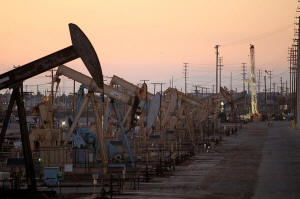Oil price gains capped by demand concerns
 Send a link to a friend
Send a link to a friend
 [March 12, 2024] By
Paul Carsten [March 12, 2024] By
Paul Carsten
LONDON (Reuters) -Oil prices rose in Tuesday trade as tensions in the
Middle East continued to spur concern, but gains were capped by bearish
demand sentiment ahead of monthly reports from oil agencies.
Brent futures for May delivery were up 48 cents, or 0.6%, at $82.69 a
barrel by 0936 GMT. The April U.S. crude contract rose 40 cents, or
0.5%, to $78.33.
Hopes of a ceasefire in Israel's war against Hamas have faded, with
negotiations deadlocked in Cairo while the conflict threatens to widen
as Israel and Lebanon's Hezbollah continue to exchange fire.
Though the Gaza conflict has not led to significant oil supply
disruptions, Yemen's Iran-aligned Houthis have been attacking ships in
the Red Sea and Gulf of Aden since November in a campaign of solidarity
with Palestinians.
Airstrikes attributed to a U.S.-British coalition hit port cities and
small towns in western Yemen on Monday and the Houthis said on Tuesday
that they had fired missiles at what they described as a U.S. ship in
the Red Sea.

Traders are becoming inured to such attacks, said John Evans at oil
broker PVM.
"The inventory of oil that might be affected is not lost, it is just
delayed - and with the new shipping times being part of the new norm,
'delayed' will eventually not be applicable," he said.
"The grind and grind of this war will continue, as will the fall away of
its relevance to oil prices."
In Russia, the world's second largest oil exporter, a Ukrainian attack
on energy facilities started a fire at Lukoil's NORSI refinery.
The various factors supporting oil prices are being countered, however,
by the demand outlook and increasing supply from producers outside the
Organization of the Petroleum Exporting Countries (OPEC).
[to top of second column] |

Oil rig pumpjacks, also known as thirsty birds, extract crude from
the Wilmington Field oil deposits area near Long Beach, California
July 30, 2013. REUTERS/David McNew//File Photo

"Bearish demand sentiment and growing non-OPEC supply leave little
room for the market to be bullish on oil prices at this time," said
Serena Huang, head of APAC analysis at Vortexa.
The International Energy Agency (IEA) expects oil supply to grow to
a record high of about 103.8 million barrels per day (bpd), almost
entirely driven by producers outside OPEC and the wider OPEC+ group
of producers. The additional supply is from countries including the
United States, Brazil and Guyana.
As for China, the world's biggest oil buyer, crude imports rose in
the first two months of the year compared with the same period of
2023. However, the imports were down from preceding months,
continuing a trend of softening purchases.
The market is awaiting demand estimates from monthly reports by
OPEC, the IEA and the Energy Information Administration, analysts
from ANZ said in a note.
"While we believe the estimates will be largely unchanged, any
upside surprise will ease demand concerns," they said.
(Reporting by Paul Carsten in London, Colleen Howe in Beijing and
Emily Chow in SingaporeEditing by David Goodman)
[© 2024 Thomson Reuters. All rights
reserved.]
This material may not be published,
broadcast, rewritten or redistributed.
Thompson Reuters is solely responsible for this content.
 |